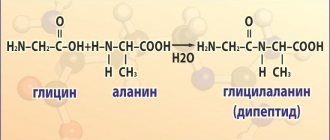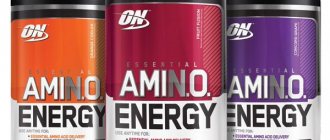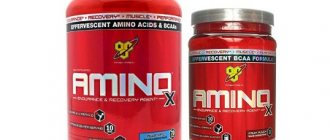Amino acids in sports nutrition are the main supplement for an athlete, as they contribute to the growth of muscle mass and rapid recovery. If their name raises doubts and concerns, it is worth understanding that these are the components of the protein molecules that we consume from food. In addition, there are amino acids that our body synthesizes independently, while others must be consumed externally.
What are amino acids and how many types are there?
Amino acids are organic compounds from which proteins are formed. The main function of amino acids is to participate in the synthesis of new cells. These are the main building materials for new muscles, so in bodybuilding it is important to consume them not only from foods, but also take them in the form of dietary supplements in the required quantities. Amino acid complexes are the main assistants to an athlete gaining muscle mass.
The main functions of amino acids in bodybuilding are to help in the growth of new tissues and prevent catabolism.
Amino acids that cannot be synthesized in the body are essential
Essential amino acids are those that cannot be generated in the human body and can only be supplied through food.
- Valine is an amino acid found in almost all proteins. Increases muscle coordination and reduces the body's sensitivity to temperature changes. Maintains the hormone serotonin at high levels.
- Isoleucine is a natural anabolic steroid that, through the process of oxidation, saturates muscle and brain tissue with energy.
- Leucine is an amino acid that improves metabolism. It is a kind of “builder” of protein structure.
- These three AMKs are part of the so-called BCAA complex, which is especially in demand among athletes. Substances in this group act as a source for increasing muscle mass, reducing fat mass and maintaining good health during particularly intense physical activity.
- Lysine is a peptide that accelerates tissue regeneration, the production of hormones, enzymes and antibodies. Responsible for the strength of blood vessels, found in muscle protein and collagen.
- Methionine – takes part in the synthesis of choline, the lack of which can lead to increased accumulation of fat in the liver.
- Threonine – gives elasticity and strength to tendons. It has a very positive effect on the heart muscle and tooth enamel.
- Tryptophan – supports emotional state, as it is converted into serotonin in the body. Indispensable for depression and other psychological disorders.
- Phenylalanine – improves the appearance of the skin by normalizing pigmentation. Supports psychological well-being by improving mood and bringing clarity to thinking.
Essential amino acids
This group cannot be synthesized independently in the body, so it is important to obtain them additionally from food. The role of such amino acids in the body and their sources are indicated in the table.
| Name | Where are amino acids found? | Role in the body |
| Valin | In cereals, legumes, peanuts, dairy products, meat and mushrooms, salmon, flour. | Participates in the growth and synthesis of tissues, maintains normal nitrogen levels in the body, and prevents a decrease in serotonin levels. |
| Isoleucine | In almonds, cashews, lentils, soybeans, eggs, meat and fish, liver. | Takes part in energy metabolism. |
| Leucine | In nuts, lentils, oats, brown rice, meat, fish and eggs. | Reduces the level of the female hormone estrone when it increases. Serves as a source of energy in the muscles. |
| Lysine | In wheat, nuts, dairy products, peas, cheese, fish and meat. | Reduces the level of triglycerides in the blood, prevents blockage of arteries. |
| Methionine | In soybeans, lentils, beans, milk, eggs, fish and meat. | It has a lipotropic effect and reduces cholesterol levels. Improves liver functions. Has an antidepressant effect. |
| Threonine | In nuts, beans, dairy products, eggs. | Takes part in the synthesis of collagen and elastin, protein-carbohydrate metabolism, and improves immunity. |
| Tryptophan | In legumes, peanuts, oats, dates, sesame seeds, dairy products, fish and meat. | Improves the functions of the nervous system, improves sleep and mood. |
| Phenylalanine | In beef, legumes, nuts, fish, meat, eggs and dairy products. | Participates in the stabilization of protein structures. |
Amino acids
In the previous article, we said that protein is, roughly speaking, a set of amino acids. So, our body includes 20 different amino acids, which will be discussed separately in this article. It is customary to classify amino acids into essential and non-essential.
Nonessential amino acids are those amino acids that can enter our body with protein foods or be formed in the body from other amino acids. Essential amino acids include: arginine, glutamic acid, glycine, aspartic acid, histidine, serine, cysteine, tyrosine, alanine, proline.
Essential amino acids are those amino acids that our body cannot produce on its own; they must be supplied with protein foods. Essential amino acids include: valine, methionine, leucine, isoleucine, phenylalanine, lysine, tryptophan, threonine.
Table of nonessential/essential amino acids
Amino acids BCAA
Of all the essential amino acids mentioned above, three are especially important for the body: valine, leucine and isoleucine. This class of amino acids has a branched chain and is widely known as BCAA (Branched Chain Amino Acids). All three amino acids have extremely valuable properties due to the special structure of the molecule. Among all essential amino acids, BCAA accounts for 42%; they play a primary role in protein metabolism and muscle energy. Read more in the BCAA article.
Now let's talk about specific amino acids, their properties and purpose:
Isoleucine is a branched chain BCAA amino acid. The main purpose is a source of energy for muscle cells. If the content of isoleucine in the body is low, drowsiness and general lethargy appear, blood sugar levels may decrease (hypoglycemia), and if there is a deficiency, muscle mass is lost.
Leucine is a branched chain amino acid from the BCAA group. The main purpose is the construction and growth of muscle tissue, the formation of protein in the muscles and liver, and prevents the destruction of protein molecules. Can also be an energy source. Prevents the decrease in serotonin levels, resulting in the body being less susceptible to fatigue. Leucine deficiency is the result of poor nutrition or lack of vitamin B6 in the body.
Valine is a branched chain BCAA group. The main purpose is a source of energy for muscle cells. Prevents the decrease in serotonin levels, resulting in the body being less susceptible to fatigue. Valine deficiency is a result of poor nutrition or lack of vitamin B6 in the body.
Lysine is an essential amino acid, the main substance for the production of carnitine. Enhances the effect of arginine. Lack of lysine slows down muscle growth.
Methionine is an essential amino acid. Purpose – prevention of fat deposition in the liver, restoration of liver and kidney tissue, accelerates protein production in cells, speeds up recovery after training. Lack of methionine slows down the growth and development of the body.
Phenylalanine is an essential amino acid. Purpose – accelerates protein production, promotes the removal of metabolic products by the liver and kidneys. Phenylalanine is a thyroid hormone that controls metabolic rate. Lack of phenylalanine slows down the growth and development of the body.
Threonine is an essential amino acid. Purpose - the production of antibodies and immunoglobulins, which ensure the normal functioning of the body's immune system. With a low threonine content, the body's energy reserves are quickly depleted. And an excess of this amino acid promotes the accumulation of uric acid in the body.
Tryptophan is an essential amino acid. As a result of taking this amino acid, human behavior becomes more balanced, and the production of growth hormone in the body increases.
Arginine is a non-essential amino acid. Purpose – restoration of the body after heavy loads, burning fat. As a result of taking this amino acid, the cholesterol level in the blood decreases.
Histidine is a non-essential amino acid. Purpose – one of the most important regulators of blood clotting. The presence of this amino acid is important for the formation of blood hemoglobin, protein metabolism, red and white blood cells. In addition, histidine alleviates and even overcomes allergy symptoms. An excess of this amino acid can lead to the loss of zinc, since histidine is able to bind this metal.
Cysteine is a non-essential amino acid. This acid is an important antioxidant; it is necessary for the growth of nails and hair. It is possible to produce cysteine from methionine.
Tyrosine is a non-essential amino acid. Purpose - to ensure normal functions of the thyroid gland, normal functioning of the adrenal glands and the formation of red and white blood cells. The use of this amino acid enhances the production of growth hormone and has a general stimulating effect on the body.
Alanine is a non-essential amino acid. Purpose: raw material for the production of glucose. In the body, alanine is formed from BCAA amino acids.
Asparagine and aspartic acid are non-essential amino acids. The body produces aspartic acid from asparagine, which is needed for the production of DNA and RNA, and is important for the immune system. The use of this amino acid increases glycogen reserves in muscles, because aspartic acid promotes the formation of glucose from carbohydrates.
Glutamine and glutamic acid are essential amino acids. In the body, ammonia combines with glutamic acid to form glutamine. Purpose – supports protein formation and fluid accumulation in the cell. Glutamine has a significant effect on the accumulation of glycogen in muscles, as well as on their energy potential. Glutamic acid is an intermediate step in the breakdown of amino acids; its consumption has a positive effect on training results.
Glycine is a non-essential amino acid. This amino acid is important for the formation of connective tissue, which weakens with a lack of glycine.
Proline is a non-essential amino acid. This amino acid is important for the heart and joints and can be used as a source of energy.
Serine is a non-essential amino acid. This amino acid is important for energy supply and immunity; it plays a critical role in cellular energy. Serin is responsible for human thought processes and memory.
Estimated reliable and optimal requirement of an adult for essential amino acids (g/100 g protein)
* - recommendations of the Food Committee of the World Health Organization (FAO/WHO).
Amino acid composition of food proteins (g/100 g protein)
* — Limiting acid
To summarize all of the above, I would like to emphasize once again that amino acids are the raw materials for the construction of all proteins in our body, without them the development and growth of muscle mass is impossible. In addition, they are involved in almost all vital processes, and you simply must provide your body with the necessary amount of amino acids, otherwise muscle growth will be impossible.
You will find information on the content of essential amino acids in specific food products in the Tables section.
You can find additional information about amino acids in the book “Amino acids - the building blocks of life” (author: Leonid Ostapenko).
In the next article we will talk about what carbohydrates are, what their role is in our body and how to take them when doing bodybuilding.
© Your Training (www.tvoytrening.ru)
The materials in this article are protected by copyright law. Copying without providing a link to the source and notifying the author is PROHIBITED!
Partially Essential Amino Acids
For example, arginine is not an essential amino acid for adults, although it is still essential for children. The amino acids themselves are partially synthesized in the body, in insufficient quantities, so it is important to take them additionally from food or supplements.
| Name | Where are amino acids found? | Role in the body |
| Arginine | In pumpkin seeds, sesame seeds, peas, meat and fish, cheese, yogurt. | Participates in nitrogen metabolism, stimulates the production of growth hormone. |
| Histidine | In soybeans, peanuts, lentils, tuna, salmon, meat. | Plays an important role in tissue growth and repair. |
Conditionally essential amino acids
These amino acids can only be synthesized in the body by obtaining essential amino acids from food, so it is important to consume foods and supplements rich in essential amino acids.
| Name | Where are amino acids found? | Role in the body |
| Tyrosine | In fish, meat, milk. | Participates in protein synthesis, helps reduce fatigue and stress. |
| Cysteine | In soybeans, oats, wheat, meat and fish. | Participates in protein synthesis, is an antioxidant, preserving vitamin C. |
Amino acids in the human body
Natural amino acids are 200 essential compounds and 200 unique formulas. They are found in free or bound form. When AMKs are synthesized independently, there are no problems. The main attention should be paid to the essential components of protein molecules, which must be obtained from the outside. They have their own formulas and basic properties needed by the body:
- improvement of brain function due to the ability to transmit nerve impulses (valine, leucine, tryptophan);
- accumulation of calcium (lysine),
- increased lipid metabolism (methionine);
- normalization of central nervous system activity (isoleucine, methionine, threonine);
- improvement of appetite (phenylalanine);
- decreased pain threshold (phenylalanine).
There are 8 essential BUNs, but control of three of them is important: valine, leucine and isoleucine (BCCA). Their formula has branched side chains. If BCCA deficiency does not occur, then the need for other amino acids will be satisfied.
Signs of deficiency and excess of amino acids
Lack or excess of BUN affects the general condition of the body. With their deficiency, the following is observed:
- poor appetite;
- state of drowsiness and weakness;
- inhibition of growth and development;
- hair loss;
- poor skin condition;
- anemia;
- weak immune defense.
The properties of AMK are such that their excess also affects health:
- With a high tyrosine content, the balance in the thyroid gland changes, and hypertension develops.
- With an excess of histidine, joint diseases and aortic aneurysm are possible. Early gray hair occurs.
- With a high concentration of methionine, there is a high risk of developing a stroke or heart attack.
Such problems are possible due to a lack of a number of vitamins (A, C, group B) and selenium. In their presence, the excess amino acid content is neutralized.
BUN balance is associated with proper nutrition and health. In the presence of chronic pathologies of the liver, gastrointestinal tract, or lack of certain enzymes, the content of the amount of AMK becomes uncontrollable.
Daily requirement for amino acids
Each amino acid with its individual formula and properties is needed by the body in certain quantities. Calculating the daily norm of the set needed by the body is difficult, since it depends on its content in 1 g of protein. The total requirement for essential amino acids is 0.5-2 g per day.
If the daily protein intake is approximately 120 g, then a person receives:
- 8.4 g leucine;
- 4.8 g isoleucine;
- 6 g valine.
These are the same BCAAs that cover the deficiency of essential amino acids. The daily norm of required protein for men is 65-120 g, for women – 60-90 g. Half of this norm comes from animal proteins. Amino acids are part of proteins, so it is possible to calculate in what quantities they enter the body.
Active metabolism of amino acids occurs:
- during the growth of the body;
- during active sports;
- under severe mental and physical stress;
- during illness and during the recovery process.
The rate of absorption of the necessary AMKs depends on individual products or their combination.
The body quickly absorbs egg whites, low-fat cottage cheese, lean meat and fish. Absorption goes well when combining milk with buckwheat porridge and white bread, flour products with meat and cottage cheese. If the body is healthy and protein intake meets the daily requirement, then you don’t have to think about the question of how to properly take amino acids. Most of the necessary protein components are found in meat, milk and eggs. Their correct distribution throughout the day will allow you to saturate the body with the necessary substances with different formulas and with properties important for metabolism.
Nonessential amino acids
These amino acids can be synthesized in the body independently, but this does not mean that the athlete does not need to take them additionally from sports nutrition supplements. For example, glutamine is taken separately, despite taking full cycle amino acids. Many non-essential amino acids are important for quality growth and recovery from mental and physical activity.
| Name | Role in the body |
| Alanin | Takes part in the synthesis of sugars and organic acids. |
| Asparagine | Promotes the removal of ammonia, reduces fatigue. |
| Glutamine | Normalizes sugar levels, reduces fatigue, improves brain function. |
| Cystine | Helps with collagen production and relieves inflammation. |
| Glycine | Promotes the production of hormones that improve immunity, provides oxygen during the formation of new cells. |
| Citrulline | Increases the body's endurance and accelerates the elimination of ammonia. |
| Ornithine | Participates in the production of somatotropin, improves liver function and enhances immune functions. |
| Proline | Helps improve the functions of ligaments and joints, strengthens the myocardium. |
| Serin | Promotes glycogen storage, improves immunity. |
| Taurine | Rids the body of free radicals. |
Amino acids in sports nutrition – what they are and why to take them
In sports nutrition you can find both amino acid complexes and a single amino acid supplement (solo):
- BCAA is a complex of three essential amino acids important for muscles: leucine, isoleucine, valine. There are capsule and powder forms.
- Full cycle amino acids - these include both essential and essential amino acids, as well as conditionally and partially essential amino acids. There are capsule, powder and liquid forms.
- Individual amino acids are also found, for example, glutamine, arginine, taurine and others.
Harm of amino acids[edit | edit code]
The main reason for writing this article was the numerous questions received about the possible harm of amino acids and side effects, as well as a provocative and illiterate article on the website VrednoLi.ru “Are amino acids harmful?”
Criticism of the article on VrednoLi.ru[edit | edit code]
After the first reading, one can clearly conclude that the author of the article has a very vague idea about amino acids, since the information presented is completely untrue.
«“When you visit resources related to the sale of amino acids for athletes, you get the impression that after eating them, the body will instantly acquire “masculine” forms and the buyer will be incredibly happy. But there is not a word about the dangers of such drugs. Is there really no harm from consuming substances unusual for humans?”
- Firstly, aminocarboxylic acids sold in sports nutrition stores are not medicines or drugs.
- Secondly, such a side effect of amino acids as food poisoning is difficult to obtain even with very “inept and irregular” use, since the average portion of the product is approximately 5 g, and food poisoning is unlikely even when consuming 30 and 50 g at a time.
- Thirdly, amino acids do not cause peptic ulcers, since they are part of any protein product (be it cottage cheese, meat or eggs). According to the author’s logic, even a portion of meat can cause an ulcer.
- And finally, the most delusional statement about impotence. Nonsense!
The harm and side effects of amino acids are a myth![edit | edit code]
To be convinced of this, you need to understand the nature of amino acids and understand what they actually are.
Amino acids
- these are the elements from which all food proteins are built. The food we consume per day contains up to 100 (WAY MORE THAN 100!!!) g of protein (corresponding to 100 g of aminocarboxylic acids). When protein enters the digestive tract, it begins to break down under the influence of enzymes into amino acids (the same ones that are present in sports nutrition), which in turn enter the blood and nourish all organs and tissues (including muscles).
Amino acid complexes for athletes are obtained from whey protein (this is a natural protein from cow's milk) by breaking it down with enzymes. In fact, it is nothing more than pre-digested protein.
Now think for yourself, can 2 eggs or a glass of milk cause stomach ulcers, impotence or other side effects? Unlikely, neither are commercially available sports supplements because, as stated above, they are derived from milk protein.
However, it is worth remembering that some amino acids in their pure form can still be physiologically active. For example, glycine, which is a neurotransmitter and has a sedative (calming), mild tranquilizing (anti-anxiety) and weak antidepressant effect, reduces feelings of anxiety, fear, psycho-emotional stress, and enhances the effect of anticonvulsants. Or glutamic acid, which has a moderate psychostimulating, stimulating and partly nootropic effect.
Why do we need sports supplements if everything is in products?[edit | edit code]
The question naturally arises: why are sports supplements better than protein products if they consist of the same substances? The answer is simple, amino acids in the form of supplements are absorbed much faster (since you don’t need to waste time on digestion), which means your muscles will receive building elements faster, recover faster and accordingly increase in volume. In addition, consuming ready-made amino acid complexes is much more convenient than eating a hearty meal before training (which goes without saying is not acceptable, everyone has long known that you need to eat at least an hour and a half before training) and after it, while the body urgently (in within 40 - 60 minutes after training) you need to get a small amount of amino acids (and in particular BCAA) to restore damaged muscle fibers.
Conclusion[edit | edit code]
Side effects of amino acids
- this is just a myth that sounds completely absurd to a person with at least a little knowledge of biochemistry and physiology. The harm to amino acids is insignificant even when the recommended doses are exceeded many times over; any even more or less competent doctor can subscribe to these words. And raising such questions can only indicate a person’s complete illiteracy in the field of nutrition, health and sports.
You just need to take into account that the human body is able to absorb no more than 5-6 g of amino acids per hour. And with systematically excessive consumption of amino acids, exceeding the norms prescribed by the product manufacturer, this can affect the functioning of organs such as the liver and especially the kidneys.
How to take sports supplements of essential and essential amino acids
BCAA
The classic form of BCAA is found in proportions 2:1:1 (leucine, isoleucine, valine). But there are also 4:1:1 ratios, so each manufacturer has its own dosages, release forms and serving sizes. Most often, 1 serving of BCAAs contains 5 g of amino acids. These servings should be consumed twice a day. Capsules are washed down with water, and powder forms are first mixed with water or juice.
The main advantage of BCAAs is the immediate prevention of catabolism, so it is advisable to take them in the morning after sleep and immediately after training. On a rest day, a second serving can be taken at any time if there is a large gap between meals.
Full cycle amino acids
One serving contains approximately 5-6 g depending on the company, usually amino acids are taken 2 times a day, excluding BCAA intake. Regardless of the release form, take the doses strictly specified by the manufacturer: one serving half an hour before training, and the second before bed or during the day when hunger strikes.
Amino acids-bioadditives
Bodybuilders actively use amino acids as nutritional supplements. There are several forms of release of these nutrients: tablets, capsules, powders, solutions and even intravenous injections.
The time and frequency of taking amino acids as dietary supplements depends on the purpose. If the drug is taken as an aid to gaining muscle mass, then you should drink amino acids before and after training, as well as in the morning. And if the drug should primarily play the role of a fat burner, you should drink it more often (how often is indicated in the instructions for use).










